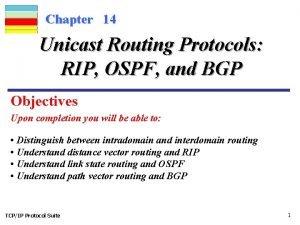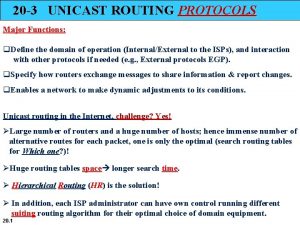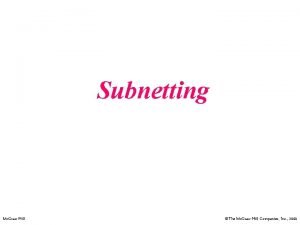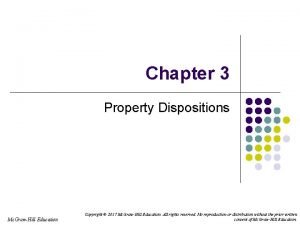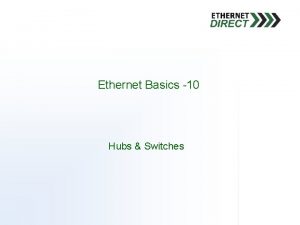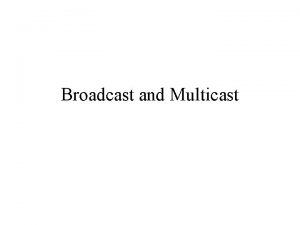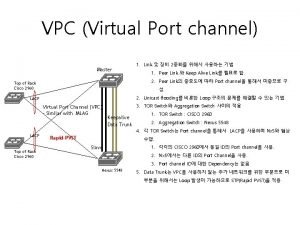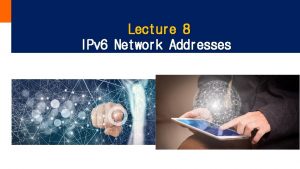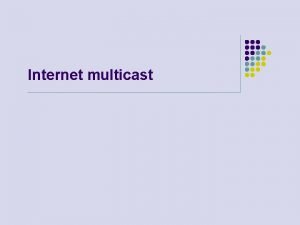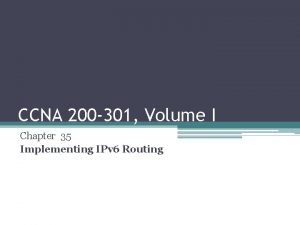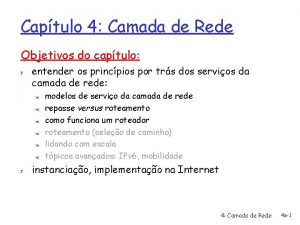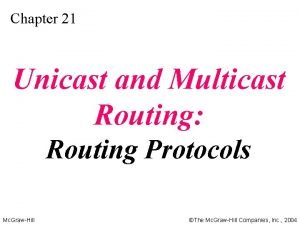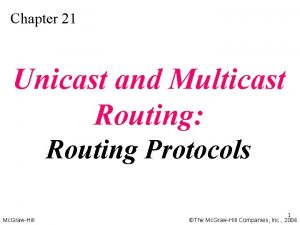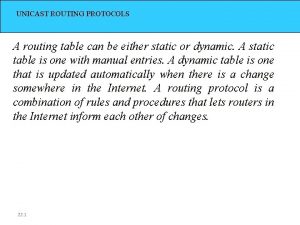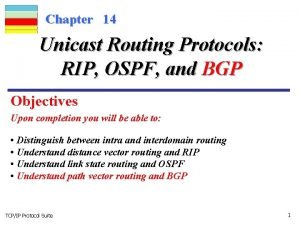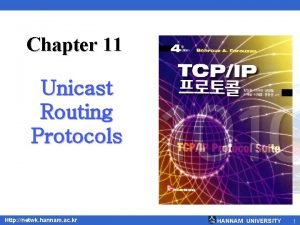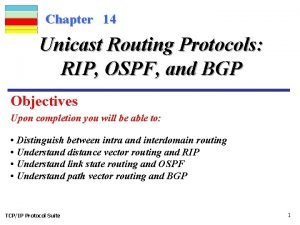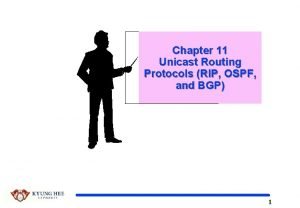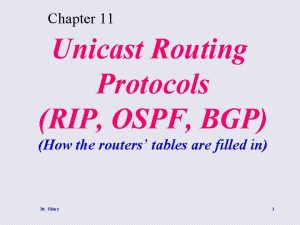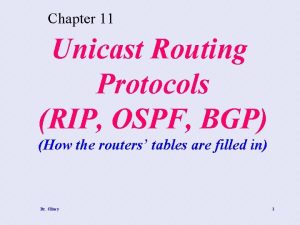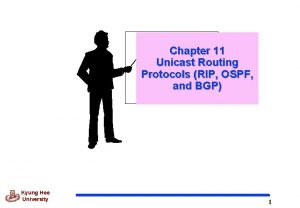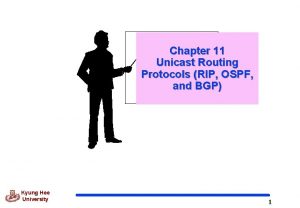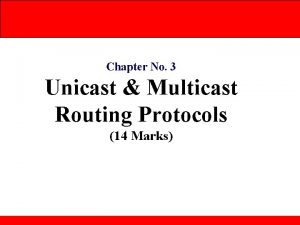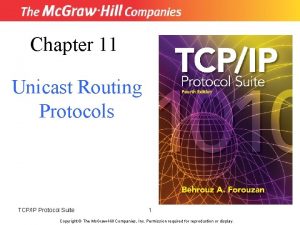Chapter 20 Unicast Routing Copyright The Mc GrawHill

























































- Slides: 57

Chapter 20 Unicast Routing Copyright © The Mc. Graw-Hill Companies, Inc. Permission required for reproduction or display.

Chapter 4: Outline 20. 1 INTRODUCTION 20. 2 ROUTING ALGORITHMS 20. 3 UNICAST ROUTING PROTOCOLS

Chapter 20: Objective q The first section introduces the concept of unicast routing and describes the general ideas behind it. The section then describes least-cost routing and least-cost trees. q The second section discusses common routing algorithms used in the Internet. The section first describes distance-vector routing. It then describes link-state routing. Finally, it explains path-vector routing. q This section first describes RIP, a protocol that implements the distance-vector routing algorithm. It next describes OSPF, a protocol that implements the link-state routing algorithm. Finally, the section describes the BGP, a protocol that implements the path-vector routing algorithm.

20 -1 INTRODUCTION Unicast routing in the Internet, with a large number of routers and a huge number of hosts, can be done only by using hierarchical routing: routing in several steps using different routing algorithms. In this section, we first discuss the general concept of unicast routing in an internet. After the routing concepts and algorithms are understood, we show we can apply them to the Internet. 20. 4

20. 1 General Idea In unicast routing, a packet is routed, hop by hop, from its source to its destination by the help of forwarding tables. The source host needs no forwarding table because it delivers its packet to the default router in its local network. The destination host needs no forwarding table either because it receives the packet from its default router in its local network. This means that only the routers that glue together the networks in the internet need forwarding tables. So, routing a packet from its source to its destination means routing the packet from a source router to a destination router The question is what other routers the packet should visit? 20. 5

Figure 20. 1: An internet and its graphical representation An internet is modeled as a weighted graph: set of nodes (routers) and edges (networks), in which each edge is associated with a cost. the cost of an edge has a different interpretation in different routing protocols. If there is no edge between the nodes, the cost is infinity.

20. 2 Least-Cost Routing When an internet is modeled as a weighted graph, one of the ways to interpret the best route from the source router to the destination router is to find the least cost between the two. In other words, the source router chooses a route to the destination router in such a way that the total cost for the route is the least cost among all possible routes. Example: In Figure 20. 1, the best route between A and E is A-B-E, with the cost of 6. 20. 7

Figure 20. 2: Least-cost trees for nodes in the internet of Figure 4. 56 A least-cost tree is a tree with the source router as the root that spans the whole graph (visits all other nodes) and in which the path between the root and any other node is the shortest. 20. 8

20 -2 ROUTING ALGORITHMS Several routing algorithms have been designed in the past. The differences between these methods are in the way they interpret the least cost and the way they create the least-cost tree for each node. In this section, we discuss the common algorithms; later we show a routing protocol in the Internet implements one of these algorithms. 20. 9

20. 2. 1 Distance-Vector Routing The distance-vector (DV) routing uses the goal we discussed in the introduction, to find the best route. In distance-vector routing, the first thing each node creates is its own least-cost tree with the rudimentary information it has about its immediate neighbors. The incomplete trees are exchanged between immediate neighbors to make the trees more and more complete and to represent the whole internet. We can say that in distance-vector routing, a router continuously tells all of its neighbors what it knows about the whole internet (although the knowledge can be incomplete). 20. 10

Figure 20. 3: Graphical idea behind Bellman-Ford equation is used to find the least cost (shortest distance) Dxy = min{(cxa + Day), (cxb + Dby), (cxc + Dcy), . . . } Dxy = min{Dxy, (cxz + Dzy)} 20. 11

Figure 20. 4: The distance vector corresponding to a tree Distance Vector : a one-dimensional array to represent the least-cost tree. Name of the distance vector defines the root Indexes define the destinations. Value of each cell defines the least cost from the root to the destination. A distance vector does not give the path to the destinations as the least-cost tree does; it gives only the least costs to the destinations. 20. 12

Figure 20. 5: The first distance vector for an internet Each node in an internet, when it is booted, sends some greeting messages out of its interfaces and discovers the identity of the immediate neighbors and the distance between itself and each neighbor. It then makes a simple distance vector (rudimentary) and leaves the value of other cells as infinity. These rudimentary vectors cannot help the internet to effectively forward a packet. For example, node A thinks that it is not connected to node G because the corresponding cell shows infinity. To improve these vectors, the nodes in the internet need to help each other by exchanging information.

Figure 20. 6: Updating distance vectors After each node has created its vector, it sends a copy of the vector to all its immediate neighbors. After a node receives a distance vector from a neighbor, it updates its distance vector using the Bellman-Ford equation (second case). The figure shows two events: In the first event, node A has sent its vector to node B. Node B updates its vector using the cost c. BA = 2. In the second event, node E has sent its vector to node B. Node B updates its vector using the cost c. EA = 4. 20. 14

Table 20. 1: Distance-Vector Routing Algorithm for A Node S 20. 15

Figure 20. 7: Two-node instability Count to Infinity If a link is broken (cost becomes infinity), every other router should be aware of it immediately, but in distance-vector routing, this takes some time. Example: Two-node loop problem. 1. At the beginning, both nodes A and B know how to reach node X. 2. Suddenly, the link between A and X fails. Node A changes its table. If A can send its table to B immediately, everything is fine. 3. The system becomes unstable if B sends its forwarding table to A before receiving A’s forwarding table. Node A receives the update and, assuming that B has found a way to reach X, updates its forwarding table. 4. Now A sends its new update to B. B thinks that something has been changed around A and updates its forwarding table. 5. The cost of reaching X increases gradually until it reaches infinity. Then, A and B know that X cannot be reached. The system is not stable. Node A thinks that the route to X is via B; node B thinks that the route to X is via A. Packets destined for X will bounce between A and B, creating a twonode loop problem. 20. 16

20. 2. 2 Link-State Routing A routing algorithm that directly follows our discussion for creating least-cost trees and forwarding tables is link-state (LS) routing. This method uses the term link-state to define the characteristic of a link (an edge) that represents a network in the internet. In this algorithm the cost associated with an edge defines the state of the link. Links with lower costs are preferred to links with higher costs; if the cost of a link is infinity, it means that the link does not exist or has been broken. 20. 17

Figure 20. 8: Example of a link-state database (LSDB): The collection of states for all links. The LSDB can be represented as a two-dimensional array(matrix) in which the value of each cell defines the cost of the corresponding link. There is only one LSDB for the whole internet; each node needs to have a duplicate of it to be able to create the least-cost tree. 20. 18

Figure 20. 9: LSPs created and sent out by each node to build LSDB how each node can create this LSDB? By flooding: Each node send LS packet (LSP) to all its immediate neighbors (each interface) to collect two pieces of information for each neighboring node: 1. The identity of the node. 2. The cost of the link. When a node receives an LSP, it compares the LSP with the copy it may already have. The node check the sequence number in both LSP to know which one is old and discards it, and keep the new one. Then the node sends a copy of it out of each interface except the one from which the packet arrived. This guarantees that flooding stops somewhere in the network (where a node has only one interface). Each node creates the comprehensive LSDB. This LSDB is the same for each node and shows the whole map of the internet. In other words, a node can make the whole map if it needs to, using this LSDB.

Compare link-state routing with distance-vector routing In the distance-vector routing algorithm, each router tells its neighbors what it knows about the whole internet; in the link-state routing algorithm, each router tells the whole internet what it knows about its neighbors. 20. 20

Table 20. 2: Dijkstra’s Algorithm S To create a least-cost tree for itself, using the shared LSDB, each node needs to run the Dijkstra Algorithm: 1. The node chooses itself as the root of the tree, creating a tree with a single node, and sets the total cost of each node based on the information in the LSDB. 2. The node selects one node, among all nodes not in the tree, which is closest to the root, and adds this to the tree. After this node is added to the tree, the cost of all other nodes not in the tree needs to be updated because the paths may have been changed. 3. The node repeats step 2 until all nodes are added to the tree. 20. 21

Figure 20. 10: Least-cost tree S The figure shows the formation of the least-cost tree using Dijkstra’s algorithm. We need to go through an initialization step and six iterations to find the least-cost tree. 20. 22

20. 2. 3 Path-Vector Routing Both link-state and distance-vector routing are based on the least-cost goal. However, there are instances where this goal is not the priority. For example, assume that there are some routers in the internet that a sender wants to prevent its packets from going through. In other words, the least-cost goal, applied by LS or DV routing, does not allow a sender to apply specific policies to the route a packet may take. To respond to these demands, a third routing algorithm, called path-vector (PV) routing has been devised. 20. 23

Figure 20. 11: Spanning trees in path-vector routing The Figure shows a small internet with only five nodes. Each source has created its own spanning tree that meets its policy. The policy imposed by all sources is to use the minimum number of nodes to reach a destination. -The spanning tree selected by A and E is such that the communication does not pass through D. - The spanning tree selected by B is such that the communication does not pass through C. 20. 24

Figure 20. 12: Path vectors made at booting time S 20. 25

Figure 20. 13: Updating path vectors S 20. 26

Table 20. 3: Path-vector algorithm for a node S 20. 27

20 -3 UNICAST ROUTING PROTOCOLS We discuss three common protocols used in the Internet: 1. Routing Information Protocol (RIP), based on the distance-vector algorithm. 2. Open Shortest Path First (OSPF), based on the link-state algorithm. 3. Border Gateway Protocol (BGP), based on the path-vector algorithm. 20. 28

20. 3. 1 Internet Structure Before discussing unicast routing protocols, we need to understand the structure of today’s Internet. The Internet has changed from a tree-like structure, with a single backbone, to a multi-backbone structure run by different private corporations today. Although it is difficult to give a general view of the Internet today, we can say that the Internet has a structure similar to what is shown in Figure 20. 14. 20. 29

Figure 20. 14: Internet structure The Internet has changed from a tree-like structure, with a single backbone, to a multi-backbone structure run by different private corporations today. 20. 30

20. 3. 2 Routing Information Protocol The Routing Information Protocol (RIP) is one of the most widely used intradomain routing protocols based on the distance-vector routing algorithm we described earlier. RIP was started as part of the Xerox Network System (XNS), but it was the Berkeley Software Distribution (BSD) version of UNIX that helped make the use of RIP widespread. RIP is normally used in small Autonomous systems (ASs). 20. 31

Figure 20. 15: Hop counts in RIP The cost is defined as the number of hops, which means the number of networks (subnets) a packet needs to travel through from the source router to the final destination host. 20. 32

Figure 20. 16: Forwarding tables A forwarding table in RIP is a threecolumn table: 1. Address of the destination network. 2. The address of the next router to which the packet should be forwarded. 3. The cost (the number of hops) to reach the destination network. 20. 33

Figure 20. 17: RIP message format RIP has two types of messages: request and response. A request message: can ask about specific entries or all entries. It is sent by a router that has just come up or by a router that has some time-out entries. A response (or update) message can be either solicited or unsolicited. - A solicited response message: sent only in answer to a request message. It contains information about the destination specified in the corresponding request message. - unsolicited response message: sent periodically, every 30 seconds or when there is a change in the forwarding table. 20. 34

Figure 20. 18: Example of an autonomous system using RIP (Part I) S Example 20. 1 Figure 20. 18 shows a more realistic example of the operation of RIP in an autonomous system. First, the figure shows all forwarding tables after all routers have been booted. 20. 35

Figure 20. 18: Example of an autonomous system using RIP (Part II) S Then we show changes in some tables when some update messages have been exchanged. 20. 36

Figure 4. 73: Example of an autonomous system using RIP (Part III) S Finally, we show the stabilized forwarding tables when there is no more change. 20. 37

20. 3. 3 Open Shortest Path First (OSPF) is also an intradomain routing protocol like RIP, but it is based on the link-state routing protocol we described earlier in the chapter. OSPF is an open protocol, which means that the specification is a public document. 20. 38

Figure 20. 19: Metric in OSPF In OSPF, like RIP, the cost of reaching a destination from the host is calculated from the source router to the destination network. However, each link (network) can be assigned a weight based on the throughput, round-trip time, reliability, and so on. An administration can also decide to use the hop count as the cost. 20. 39

Figure 20. 20: Forwarding tables in OSPF Each OSPF router can create a forwarding table after finding the shortest-path tree between itself and the destination using Dijkstra’s algorithm. Comparing the forwarding tables for the OSPF and RIP in the same AS: The only difference is the cost values. 20. 40

Figure 20. 21: Areas in an autonomous system OSPF was designed to be able to handle routing in a small or large AS. The flooding may not create a huge volume of traffic in a large AS. To prevent this, the AS needs to be divided into small sections called areas. Each area acts as a small independent domain for flooding LSPs. One of the areas in the AS is designated as the backbone area, responsible for gluing the areas together. The routers in the backbone area are responsible for passing the information collected by each area to all other areas. 20. 41

Figure 20. 22: Five different LSPs (Part I) OSPF requires that a router advertise the following to all neighbors for the formation of the LSDB: • The existence of different entities as nodes. • The different types of links that connect each node to its neighbors. • The different types of cost associated with each link. This means we need different types of advertisements, each capable of advertising different situations. We can have five types of link-state advertisements: 1. Router ink. 2. Network link. 3. Summary link to network. 4. Summary link to AS border router. 5. External link. 20. 42

Figure 20. 22: Five different LSPs (Part II) 20. 43

Figure 20. 23: OSPF message formats (Part I) S Attention 20. 44

Figure 20. 23: OSPF message formats (Part II) S Attention 20. 45

20. 3. 4 Border Gateway Protocol The Border Gateway Protocol version 4 (BGP 4) is the only interdomain routing protocol used in the Internet today. BGP 4 is based on the path-vector algorithm we described before, but it is tailored to provide information about the reachability of networks in the Internet. 20. 46

Figure 20. 24: A sample internet with four ASs In our example, data exchange between AS 2, AS 3, and AS 4 should pass through AS 1. Each autonomous system in this figure uses one of the two common intradomain protocols, RIP or OSPF. Each router in each AS knows how to reach a network that is in its own AS, but it does not know how to reach a network in another AS. To enable each router to route a packet to any network in the internet, we install: • External BGP (e. BGP) on each border router. - Internal BGP (i. BGP), on all routers. So, the border routers will run three routing protocols (intradomain, e. BGP, and i. BGP), but other routers are running two protocols (intradomain and i. BGP). 20. 47

Figure 20. 25: e. BGP operation e. BGP allows two physically connected border routers in two different ASs to form pairs of e. BGP by creating a TCP connection using the well-known port 179. A simplified update messages sent by routers involved in the e. BGP sessions. For example, message number 1 is sent by router R 1 and tells router R 5 that N 1, N 2, N 3, and N 4 can be reached through router R 1. Router R 5 add this information at the end of its forwarding table. When R 5 receives any packet destined for these four networks, it can find in its forwarding table that the next router is R 1. 20. 48

Figure 20. 26: Combination of e. BGP and i. BGP sessions in our internet The i. BGP protocol is similar to the e. BGP protocol in that it uses the service of TCP on the well-known port 179, but it creates a session between any possible pair of routers inside an autonomous system. in this stage only four messages are exchanged. Foe example, the first message (1) is sent by R 1 announcing that networks N 8 and N 9 are reachable through the path AS 1 -AS 2, but the next router is R 1. 20. 49

Figure 20. 27: Finalized BGP path tables (Part I) The updating process continue. Then, each router combines the information received from e. BGP and i. BGP and creates a path table after applying the criteria for finding the best path. 20. 50

Figure 20. 27: Finalized BGP path tables (Part II) The updating process continue. Then, each router combines the information received from e. BGP and i. BGP and creates a path table after applying the criteria for finding the best path. 20. 51

Figure 20. 27: Finalized BGP path tables (Part III) The updating process continue. Then, each router combines the information received from e. BGP and i. BGP and creates a path table after applying the criteria for finding the best path. 20. 52

Figure 20. 28: Forwarding tables after injection from BGP (Part I) S 20. 53

Figure 20. 28: Forwarding tables after injection from BGP (Part II) S 20. 54

Figure 20. 29: Format of path attribute S 20. 55

Figure 20. 30: Flow diagram for route selection S 20. 56

Figure 20. 30: BGP messages S 20. 57
 Write a detailed note on unicast routing protocols
Write a detailed note on unicast routing protocols What is unicast routing
What is unicast routing Flood routing types
Flood routing types Mark tinka
Mark tinka Hydrologic routing and hydraulic routing
Hydrologic routing and hydraulic routing Clock skew
Clock skew Grawhill
Grawhill Grawhill
Grawhill Grawhill
Grawhill Grawhill
Grawhill Mc grawhill
Mc grawhill Mc grawhill
Mc grawhill Grawhill
Grawhill Mc grawhill
Mc grawhill Grawhill
Grawhill Unicast multicast差異
Unicast multicast差異 Luoyi fu
Luoyi fu Unicast
Unicast Hub is a unicast device
Hub is a unicast device Unicast multicast broadcast address example
Unicast multicast broadcast address example Vpc vs lacp
Vpc vs lacp Unicast
Unicast Unicast vs multicast
Unicast vs multicast Unicast
Unicast Floating static route
Floating static route Global unicast
Global unicast Unicast vs multicast
Unicast vs multicast Hát kết hợp bộ gõ cơ thể
Hát kết hợp bộ gõ cơ thể Lp html
Lp html Bổ thể
Bổ thể Tỉ lệ cơ thể trẻ em
Tỉ lệ cơ thể trẻ em Voi kéo gỗ như thế nào
Voi kéo gỗ như thế nào Thang điểm glasgow
Thang điểm glasgow Chúa yêu trần thế alleluia
Chúa yêu trần thế alleluia Các môn thể thao bắt đầu bằng tiếng nhảy
Các môn thể thao bắt đầu bằng tiếng nhảy Thế nào là hệ số cao nhất
Thế nào là hệ số cao nhất Các châu lục và đại dương trên thế giới
Các châu lục và đại dương trên thế giới Công thức tính thế năng
Công thức tính thế năng Trời xanh đây là của chúng ta thể thơ
Trời xanh đây là của chúng ta thể thơ Mật thư tọa độ 5x5
Mật thư tọa độ 5x5 Phép trừ bù
Phép trừ bù độ dài liên kết
độ dài liên kết Các châu lục và đại dương trên thế giới
Các châu lục và đại dương trên thế giới Thể thơ truyền thống
Thể thơ truyền thống Quá trình desamine hóa có thể tạo ra
Quá trình desamine hóa có thể tạo ra Một số thể thơ truyền thống
Một số thể thơ truyền thống Cái miệng nó xinh thế chỉ nói điều hay thôi
Cái miệng nó xinh thế chỉ nói điều hay thôi Vẽ hình chiếu vuông góc của vật thể sau
Vẽ hình chiếu vuông góc của vật thể sau Biện pháp chống mỏi cơ
Biện pháp chống mỏi cơ đặc điểm cơ thể của người tối cổ
đặc điểm cơ thể của người tối cổ Ví dụ về giọng cùng tên
Ví dụ về giọng cùng tên Vẽ hình chiếu đứng bằng cạnh của vật thể
Vẽ hình chiếu đứng bằng cạnh của vật thể Phối cảnh
Phối cảnh Thẻ vin
Thẻ vin đại từ thay thế
đại từ thay thế điện thế nghỉ
điện thế nghỉ Tư thế ngồi viết
Tư thế ngồi viết Diễn thế sinh thái là
Diễn thế sinh thái là
